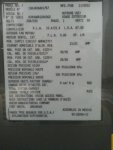JohnDS
Senior Member
- Location
- Suffolk, Long Island
- Occupation
- Electrician
Hey Guys. As you can see, the nameplate data says 35a max overcurrent protection.
1) Would 10awg be ok with 30a breaker or isnt a 35a breaker an odd ball?
If I should seek out a 35a breaker, should I upsize to 8awg or would 10awg still be ok?
Thanks guys, I was always told in the past to go with max oc protection when dealing with a.c. equipment, but a litte confused as I havent tackled one of these in a while. Thanks again.

Sent from my SGH-T999 using Tapatalk
1) Would 10awg be ok with 30a breaker or isnt a 35a breaker an odd ball?
If I should seek out a 35a breaker, should I upsize to 8awg or would 10awg still be ok?
Thanks guys, I was always told in the past to go with max oc protection when dealing with a.c. equipment, but a litte confused as I havent tackled one of these in a while. Thanks again.

Sent from my SGH-T999 using Tapatalk
